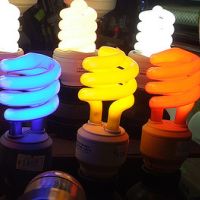There are four main methods of detection in Western blotting: radioisotopes, chromogenic substances, chemiluminescence and fluorescence. Radioisotopes and chromogenic substances were first used to detect proteins bound to a membrane. These earlier methods have disadvantages. Although extremely sensitive, radioisotopes have safety issues and require strict waste handling and disposal procedures. Chromogenic substrates lack high sensitivity and the produced color fades over time preventing long-term archival of data.
In contrast, chemiluminescence is extremely sensitive and convenient kits have made it one of the most popular methods for Western blotting. Chemiluminescent substrates emit light when reacted with an antibody conjugated to an enzyme (e.g. horse radish peroxidase). The emitted light can be captured and archived on x-ray film (traditional), or through digital imaging. The chemiluminescent reaction is an enzyme-substrate reaction that changes in intensity over time. It is susceptible to local differences in enzyme and substrate concentrations and the reaction can saturate. This limits the dynamic range of detection. It also means that chemiluminescent Western blots are only semi-quantitative.
A truly quantitative Western can be obtained through the use of fluorescently-conjugated antibodies. Fluorescent Westerns have the added benefit of the use of differing spectral wavelengths allowing the detection of multiple proteins simultaneously. For these reasons, fluorescent Western blotting is becoming increasingly popular.
This guide focuses on the benefits and drawbacks of fluorescent Western blotting in addition to providing tips for performing fluorescent Westerns in the laboratory.
Fluorescent Western Blotting
In fluorescent Western blotting, the detection antibody (usually a secondary antibody) is directly conjugated to a fluorescent dye. After incubation with the fluorescently-labeled antibody, the membrane is placed in an imager capable of producing and detecting the appropriate excitation and emission wavelengths for the dye. The image is then captured and archived digitally.
With the appropriate imager, fluorescent Western blotting is convenient as it provides a one-step imaging methods. Multiple film exposures and development steps are not required.
Fluorescently-conjugated antibodies are available in a variety of non-overlapping emission/excitation spectra, including those in the infrared region. For example, Advansta sells several antibodies for use in fluorescent Western blots. These include traditional fluorescent antibodies labeled with APC (allophycocyanin; emission maximum 675.5 nm) and RPE (R-phycoerythrin; emission maximum 578 nm) and near infrared antibodies with emission maximums at 700 nm and 800 nm, respectively.
Benefits of Fluorescent Western Blotting
Although not traditionally as sensitive as chemiluminescent Western blotting, fluorescent Westerns have several advantages over chemiluminescent blots.
Increased dynamic range
Fluorescent dyes do not rely on enzyme-substrate kinetics, which can saturate and be susceptible to local enzyme concentrations. The amount of fluorescent dye is directly proportional to the amount of protein on the membrane. This leads to a dynamic range of more than six logs.
Higher resolution
Traditional X-ray film used in the detection of chemiluminescent Western blots can detect 150 shades of gray. Digital imagers however, can visualize 216 shades of infrared signal leading to higher resolution of bands.
Extended signal duration
Fluorescent dyes are extremely stable. Blots can be processed and imaged at a convenient time. Blots can also be archived and imaged months after the initial experiment.
Ability to multiplex
The biggest benefit to fluorescent Western blotting is the ability to multiplex, or detect multiple proteins or protein variants simultaneously on the same blot. Multiplexing is useful for:
- In-lane normalization
- Detecting loading controls
- Studying posttranslational modifications
- Detecting proteins of similar molecular weight
Tips for Fluorescent Westerns
Titrate antibodies to find highest signal to noise ratio
A checkerboard titration can be performed to aid in titration. When transitioning from chemiluminescent Western blots, primary antibody concentrations may need to be increased 2-5 fold while secondary antibody concentrations may also need to be increased. A recommended starting dilution for the secondary antibody is 1:5000.
Use a membrane with low autofluorescence
Traditional membranes, particularly nitrocellulose membranes, autofluoresce causing high background. Several manufacturer’s sell low autofluorescence PVDF membranes for fluorescent Western blotting.
Use pencils to mark the blot
Pen ink can fluoresce causing high background.
Do not use dyes that fluorescent
Certain dyes, such as Coomassie blue and bromophenol blue fluoresce causing high background. Do not stain your gel prior to transferring. Do not include bromophenol blue in the protein loading dye. Alternatively, the dye front can be allowed to migrate out of the gel if it migrates significantly faster than the protein of interest.
If using fluorescent molecular weight markers, leave an empty lane between the markers and the samples. Markers may be significantly brighter than samples.
Always handle the membrane with gloved hands
Limit background due to fingerprints and smudges by always handling the membrane with gloved hands.
If archiving blots, store them away from light to prevent bleaching
Blots can be stored and archived for months without losing signal intensity. However, stored blots should be shielded from light.
Drawbacks of Fluorescent Westerns
Not as sensitive as chemiluminescent Westerns
Chemiluminescent Westerns can be 10-100 times more sensitive than fluorescent Westerns. Therefore, a chemiluminescent Western may give a better signal when detecting low abundance proteins or when using poor quality antibodies.
Establishing new conditions
When switching from a chemiluminescent protocol, antibodies may need to be re-titrated for use in fluorescent Westerns. Blocking buffers may also need to be adjusted. All-in-one kits, such as Advansta’s WesternBright MCF kits, can aid in optimization of conditions. The WesternBright MCF kits provide fluorescently labeled antibodies, low fluorescence membranes and blocking and washing solutions optimized for fluorescent Westerns.
A fluorescence imager is required
A fluorescence imager is required to perform fluorescent Western blots. Fluorescent imagers can range in price from $30,000-100,000 depending on the capabilities of the imager. Fluorescence imagers can be purchased as a core instrument for a department or jointly between labs to help defray costs.
Photo courtesy of the.Firebottle.


